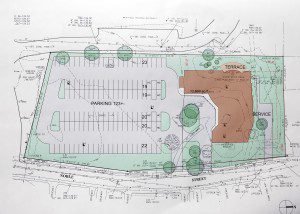
An overview drawing of the proposed Westfield Senior Center that will be located on Noble Street. (File photo by Frederick Gore)
WESTFIELD – The city’s senior center design is 85 percent complete, but it was obvious yesterday afternoon at the Building Committee meeting that the final 15 percent may require many last-second decisions, some painful, to bring the project within the $7 million budget by April 2 when the project will be released for contract bids.
Much of the discussion related to the scope of work, deciding what cost-effective options may be exercised to keep the building construction within budget, items that can be replaced with less expensive options, items that can be initially deferred and done at a later time, and items that can be cut from the scope of work.
Much of that discussion focused on the demographics of the senior center user clientele, the city’s 8,000 senior citizens, such as substituting concrete unit pavers with scored concrete to provide a smoother surface for seniors with mobility issues, who have to use walkers or canes. The pavers create an uneven surface and cost more than sheet concrete because of the labor needed to install them.
A number of options included work or items that can be added to the center at a later date. Committee members discussed reducing the paved area of the parking lot, with the idea of completing the paving later.
Much of the meeting focused on materials and the length of product warranties.
The members also discussed not installing a stand-by generator, a savings of between $50,000 and $60,000, but instead only installing the wiring for the generator that could be installed at a later date.
A major focus of the discussion pertained to contract alternates, a discussion hampered by the lack of dollar amounts for those items. The other issue is to advertise the contract with add-on alternates or subtraction alternates. The add-on approach starts with a base bid, then allows expansion of the contract by adding additional equipment up to the $7 million funding level, while the subtraction approach starts with a base bid, the subtracts items down to the funding level.
City Purchaser Tammy Tefft said the city normally uses the add-on approach because contractors have more certainty about the scope of work and give better base bids.
Tim Singleton of Diversified Project Management of East Hartford, Conn., the city’s Owners Project Manager, said that the timing of the contract release in April might benefit the city when contractors seek work for the fall construction start of the center.
“Commercial construction is down this year compared to the past couple of years so that could result in more competitive bids,” Singleton said. “Also the September construction start comes right after contractors are closing out their big summer projects, so they’d have a fall-winter project.”
Singleton said the project should be “squared away” by March 24 so it can be advertised in the state’s central registry of construction projects. Singleton said that he would increase the list of items, and the cost estimates for those items, to continue the discussion of contract alternates at the next committee meeting slated for that date.

